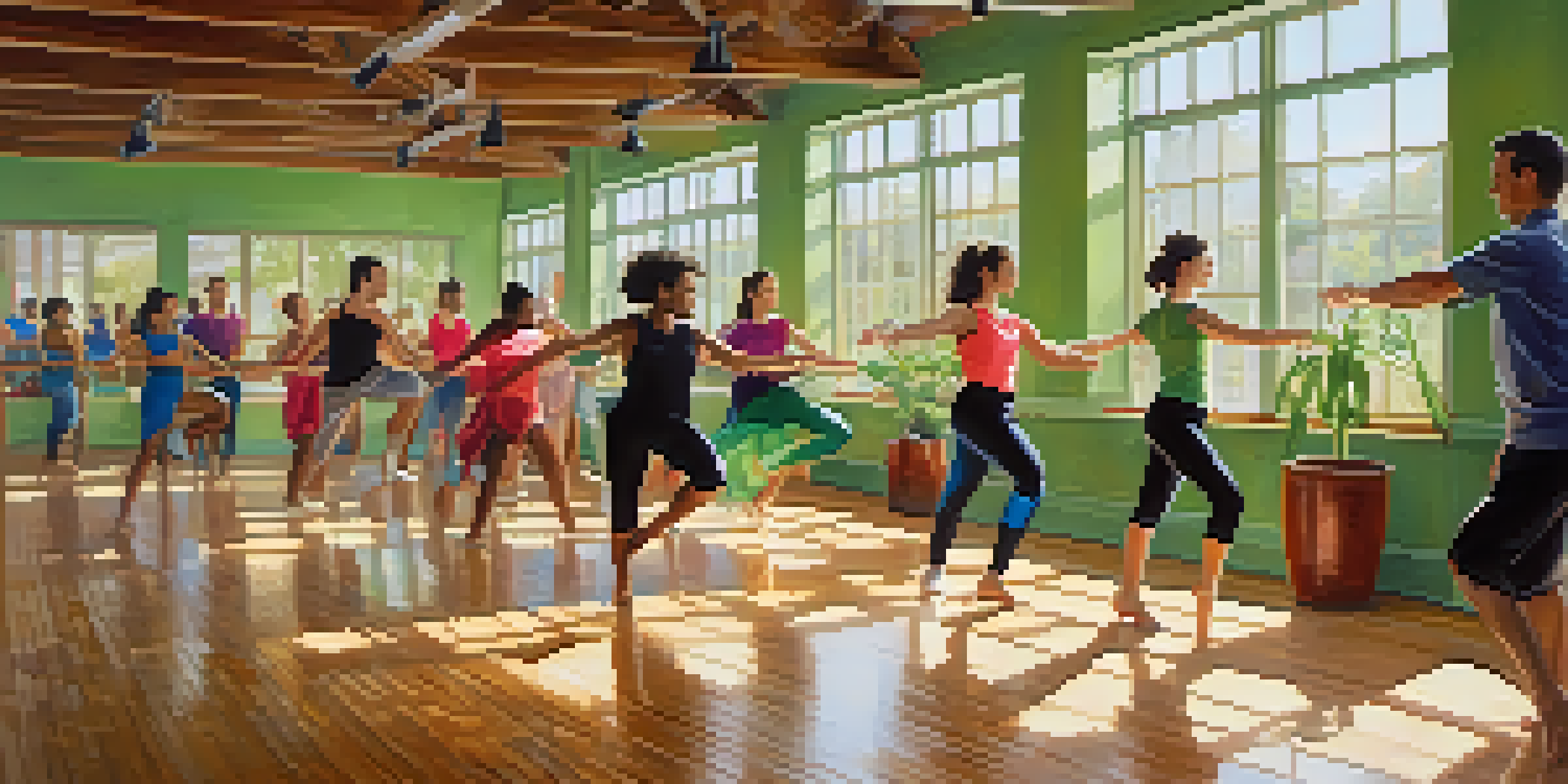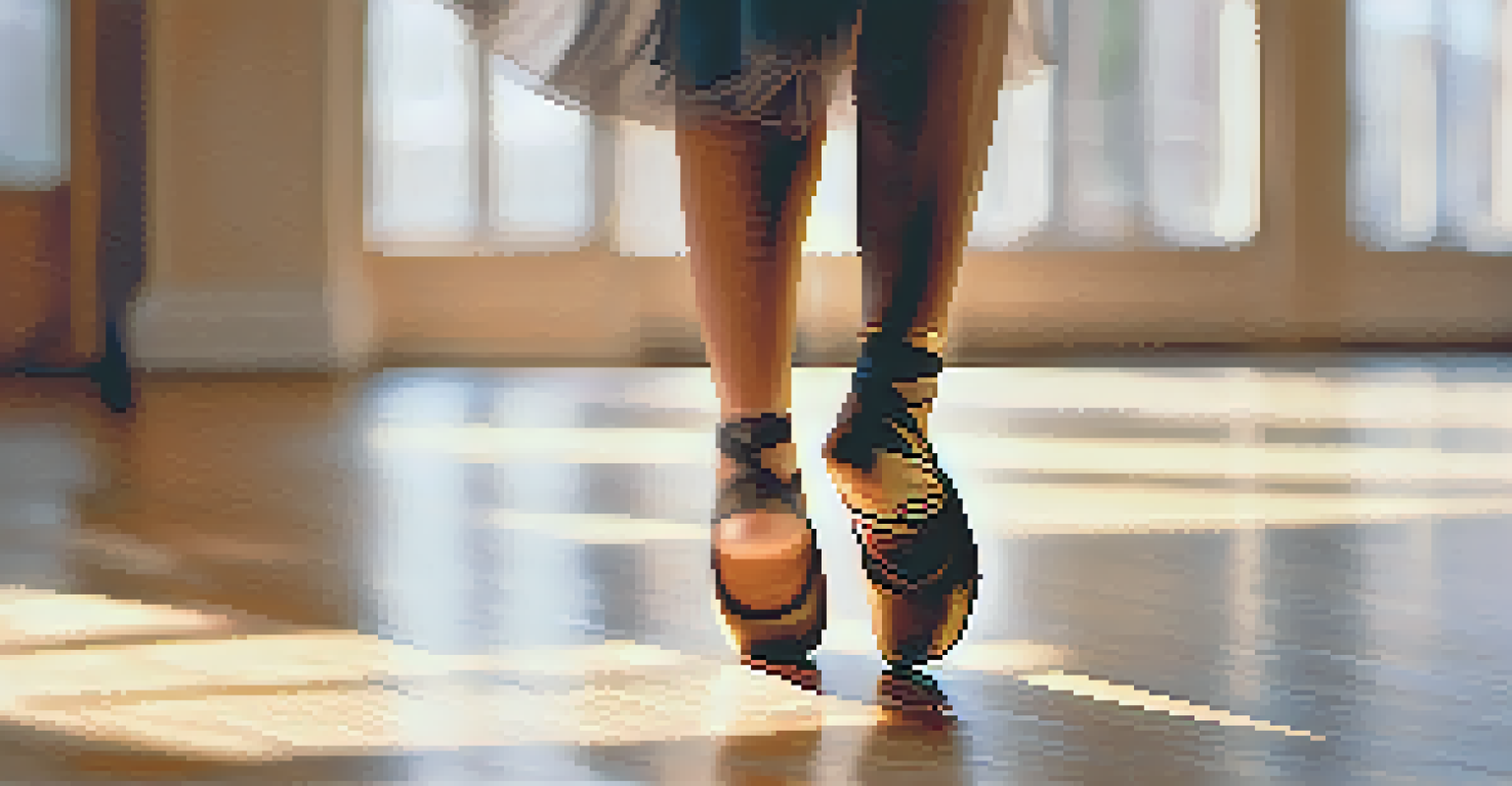Dance: A Pathway to Overcoming Personal Challenges

The Healing Power of Dance in Personal Struggles
Dance has long been recognized as a form of expression and creativity, but its impact on personal challenges can be profound. When we dance, we tap into emotions that might otherwise be difficult to express. Whether it's joy, sadness, or frustration, moving our bodies allows us to release pent-up feelings and find relief from stress.
Dance is the hidden language of the soul.
For many, dance becomes a therapeutic outlet. Imagine a person coping with grief; as they sway to music, they might find solace in the rhythm, helping them process their emotions in a way that words cannot. This emotional release can be incredibly healing and provide a sense of clarity amidst chaos.
Moreover, the physical act of dancing can boost our mood and energy levels. The endorphins released during movement create a natural high, which is especially beneficial when facing obstacles in life. It's like a breath of fresh air, lifting our spirits and encouraging resilience.
Building Confidence Through Dance
Dance not only allows for emotional expression but also serves as a powerful tool for building self-confidence. When individuals learn new dance moves or routines, they experience a sense of achievement that can translate to other areas of life. Each small victory on the dance floor reinforces a belief in one's abilities.

Consider someone who has struggled with self-esteem; as they practice their dance skills, they begin to see their progress. This newfound confidence can spill over into daily interactions, making them feel more empowered to tackle challenges outside the studio. It's amazing how a little rhythm can transform one's mindset.
Dance as Emotional Release
Dance serves as a therapeutic outlet, helping individuals process emotions like grief and stress through physical movement.
Furthermore, dancing in a group setting fosters a sense of community and support. Sharing the dance floor with others creates bonds and eliminates feelings of isolation, which can often accompany personal struggles. This collective energy enhances confidence and encourages individuals to be their authentic selves.
Dance as a Form of Mindfulness
Engaging in dance can serve as an effective practice for mindfulness, a technique that encourages us to live in the moment. When we focus on our movements and the music, we momentarily forget our worries and immerse ourselves in the present. This shift in focus can be incredibly liberating when facing personal challenges.
The dance is a poem of which each movement is a word.
For example, during a dance class, participants often find themselves lost in the rhythm, allowing their minds to quiet. This meditative state can provide clarity and perspective, helping individuals navigate their personal struggles with renewed strength. It's akin to hitting a reset button for the mind.
Additionally, the physicality of dance requires us to be aware of our bodies, which enhances our connection to ourselves. By tuning into our movements and breath, we cultivate a deeper understanding of our emotions and how they manifest physically. This awareness can lead to healthier coping strategies in times of difficulty.
Dance as a Catalyst for Social Connections
One of the beautiful aspects of dance is its ability to bring people together. Whether it's a salsa class, a dance party, or a community performance, these social settings foster connections and friendships that can be invaluable when facing personal challenges. The support from a dance community can make a significant difference in one's journey.
Imagine someone who feels alone in their struggles; by joining a dance group, they meet others who share similar experiences. This sense of belonging can combat feelings of isolation and provide encouragement and accountability. After all, we're all in this together, and dance makes it easier to connect.
Building Confidence Through Dance
Learning new dance moves fosters self-confidence, empowering individuals to tackle life’s challenges with a renewed sense of belief in their abilities.
Moreover, dancing with others can create shared experiences that strengthen bonds. These moments of laughter, joy, and even vulnerability on the dance floor can cultivate lasting relationships. When we support each other through dance, we build a network of resilience that helps us face life's challenges head-on.
The Role of Dance in Self-Discovery
Dance is not just about movement; it can also be a journey of self-discovery. As individuals explore various dance styles, they often uncover aspects of their personality and creative potential that they may not have realized existed. This exploration can help them better understand themselves and their challenges.
For instance, someone who feels constrained by societal expectations may find liberation in expressive dance forms like contemporary or improvisational styles. This newfound freedom allows them to break away from limitations and embrace their true selves. Dance becomes a powerful medium for personal growth and exploration.
Additionally, experimenting with dance can prompt individuals to confront their fears and insecurities. Whether it's performing in front of an audience or trying a new style, these experiences can be transformative. They encourage individuals to step outside their comfort zones, ultimately leading to greater self-acceptance and resilience.
Finding Joy in Movement Amidst Challenges
In times of personal struggle, it can be easy to lose sight of joy. However, dance offers a powerful reminder of life's pleasures, encouraging individuals to find happiness in movement. Whether it's a solo dance in the living room or a lively routine with friends, these joyful moments can uplift spirits and provide respite from difficulties.
Consider the simple act of dancing to a favorite song; the rhythm, melody, and even the lyrics can evoke feelings of joy and nostalgia. Engaging in such moments can shift our perspective, reminding us that happiness is still within reach, even amid life’s challenges. It’s a celebration of the present.
Dance Fosters Social Connections
Joining a dance community combats feelings of isolation and creates supportive relationships that enhance resilience during personal struggles.
Moreover, creating joyful experiences through dance can serve as a coping mechanism. When individuals make space for laughter and fun, they build resilience against life's hurdles. These moments remind us that challenges are a part of life, but so is the ability to find joy, even in the smallest of things.
Conclusion: Embracing Dance as a Tool for Growth
In conclusion, dance offers a multifaceted approach to overcoming personal challenges. From emotional healing and confidence-building to fostering social connections and self-discovery, the benefits are vast and varied. Embracing dance as a tool for growth can help individuals navigate life's obstacles with grace and resilience.
As we reflect on the interplay between dance and personal challenges, it becomes clear that movement is not just a physical act but a pathway to transformation. Just like a dancer learns to adapt to the rhythm, we can learn to adapt to the rhythms of life, finding strength in our journey.

So whether you're a seasoned dancer or just starting out, remember that dance can be a powerful ally in overcoming challenges. So go ahead, turn up the music, and let the dance lead you to new horizons in your personal journey.